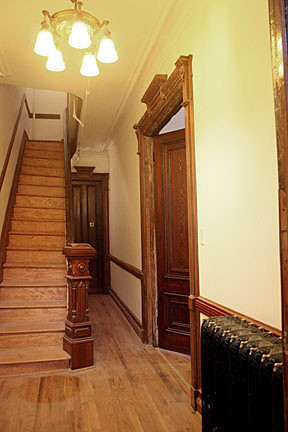
If your renovation is costing more than you paid for your house, something is wrong. You shouldn’t have to sell your first born to update a home. Sure, there are certain large ticket items you wouldn’t want to skimp on….roof, windows, facade, boiler, structural. But semi-skilled work? Come on.
As you know, I’m a big advocate for DIY. If you put in the sweat equity, you can be save yourself in the vicinity of $40k. I came up with that estimate by comparing DIY input to that of an unskilled day laborer at $125 per day over the course of a year. My own skills are superior to a guy you pick up at Home Depot, so my own estimate is probably double that. Obviously you wouldn’t quit your $200k per year job to do it, but as a freelancer earning bupkas, I was able to put in the time. My husband who put in a lot less time because he actually has a full time job and does earn something, probably saved us even more while only working on the house on weekends. That’s because he has mad skills.
Before I go into materials, just a few thoughts on other ways to save on labor. Painting and demolition parties, barters, hiring apprentices to high end contractors and of course picking up day laborers.
Materials range from free to high end. Since this has the words “tight budget” in the post title, guess where I’m going with this?
FREE
It would be a fun experiment to try to do an entire renovation free of cost. But nothing is ever free. It would take tons of time and probably cost more in fuel than trying to buy locally. But here goes…..
1. Craigs List. Go directly to the “free” section. You may find anything from sheetrock scraps to clawfoot tubs. People measure wrong, decide to use something else or may want to recycle what they are ripping out.
2. Freecyle.org Sign up for the group to gain access to a nationwide network of recycled goodies. IMO, it sounds a whole lot better than it is. When I signed up, I couldn’t believe the audacity of some people. One of the requests I saw was for a minivan for someone with 8 kids. Hello, maybe you should stop having kids if you can’t afford a van! But I digress. You can post your own needs, search for what’s out there and offer up what you no longer want.
3. Dumpster Diving. Oh yeah! I’m talking dumpsters parked outside of a renovation, obviously. Better still, find the fixer uppers that have just closed, contact contractors and demolition guys to see if they’ll give you the head’s up. No, they won’t be happy, but one or two of them might not think it’s great to stick everything in the landfill. You know, those sensitive contractors.
Almost Free
1. Craigslist. This time search “materials”.
2. ReStores. Located throughout the US and Canada. Run by Habitat for Humanity, these shops take donations from the public and sell the items at a fraction of the cost. They have everything including the kitchen sink. Paints, cabinets, light fixtures, furniture….
3. Build it Green. I saw a coffin in here once. If you live in NYC, this place is just as good as any Restore since the closest ReStore is in Mt. Vernon. BIG is a huuuuge warehouse in Queens. They have new and used studs, wiring, cabinets, doors, windows, appliances and more. Do keep in mind that items like plywood, sheetrock and studs go quickly as these are basic to any renovation.
4. Salvage! There are antique architectural salvage yards all over the planet. Although you might sometimes find a bargain at Olde Good Things or Demolition Depot, they are not for the shallow pocketed. My two local faves: Eddie Hibbert in Clinton Hill and Vaccaro’s in Gowanus. I’m talking antique french doors for 20 bucks and marble mantels for less than $400. *They may need work.
5. Overstock and Closeouts. Every now and then, manufacturers need to get rid of some clutter. There are samples, irregulars and dead stock taking up space. They don’t always post it online, but I’ll give you a for instance. I once found the mother load of concrete tiles, countertops and sinks on Craigslist. Get Real Surfaces in Poughkeepsie was having a sale to get rid of dead inventory. I made out with enormous boxes of tile for $10 per box. They were probably worth about $20 per square foot.
6. Ebay. Did you know that you can buy faucets, toilets and tools on Ebay? Yep, it’s all there!
7. Overstock.com. Sometimes good for faucets, shower and light fixtures, tiles…it kind of depends on what they have that week. Hit or miss.
Upscale. Low Budget
Green Demolitions. Buy what the millionaires got tired of looking at. Top shelf appliances (think Viking, Sub Zero) and cabinets for a ton less than what you would pay new. These aren’t completely inexpensive, but it’s a good deal for what it is!
PS: Side effects may include saving the planet while saving your pocketbook.




























